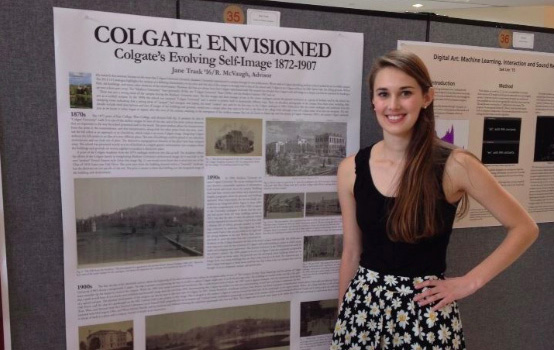
Jane Traskβs summer research project was titled β΄σΟσ΄«Γ½ Envisioned,β studying how the university presented its self-image in the past.
΄σΟσ΄«Γ½ students are sharing their experiences conducting research with faculty members on campus and in the field. This post is by Jane Trask β16, a history major from Springfield, Ill.
This summer, Iβm researching ΄σΟσ΄«Γ½βs self-image through its own published materials from 1832β1908. Iβve spent most of my time in the examining the course catalogues, yearbooks, viewbooks, photographs, prints, and other documents from this period to explore how ΄σΟσ΄«Γ½ has understood itself as a place and presented this understanding to the public.
Today, ΄σΟσ΄«Γ½βs incredible campus is a significant part of its published self-image. However, I have found that ΄σΟσ΄«Γ½ has not always understood itself in this way.
Before 1890, the year that Madison University became ΄σΟσ΄«Γ½ University, images and texts describing the school lacked a sense of connection to the physical environment. For example, prints found in the catalogues from this time do not show the hill, which today is a defining feature of the campus. The university is shown in these early materials as a set of facilities in a generic environment.
In the 1890s, wide, complete views of βthe Hillβ and detailed texts about the structures and location began to appear, demonstrating that the school was thinking of itself as a βcampusβ of integrated buildings, grounds, and paths, although it was not yet a ΄σΟσ΄«Γ½ that would be fully recognizable today.
The campus continued to develop over the course of this decade and the next, and by the publication of a 1907 viewbook, the beginnings of the modern ΄σΟσ΄«Γ½ had emerged. These images show the campus resembling a well-groomed park, with polished landscaping, the picturesque lake, and buildings nestled into the Hill.
By the end of my period of study, 1908, ΄σΟσ΄«Γ½ was thinking of and presenting itself as it does today: a special place in which the buildings, grounds, and institution are woven together to create a unique experience.
This project was conducted under in the art and art history department. He created the project and advised me throughout, but also allowed me a great deal of freedom. We met weekly to review my findings and discuss the next steps. Sarah Keen, Allyson Smally, and Lisa King in the archives also provided me with daily assistance.
I have concluded my research by compiling a report that discusses each type of material and its contents in regards to ΄σΟσ΄«Γ½βs campus and self-image in this period. In the future, Professor McVaugh and other researchers will be able to use this report, along with my spreadsheet of notes and sets of images, to find information about these materials and direct their research through them. It is possible that my research will play some role in the preparations for the 2019 Bicentennial as well, but it will primarily be used as a guide for future researchers.
I was first introduced to this type of research in the fall of 2013 when I took Professor McVaughβs American Campus Architecture course. I was fascinated by the study of the architecture of different campuses around the country, including ΄σΟσ΄«Γ½βs.
Through this project, I have further learned about how archival research works and how to efficiently collect and organize textual and visual data. A and an minor, Iβm considering going into a career in architecture or architectural history.
